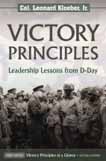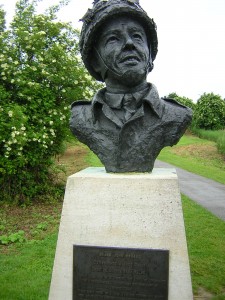Archive for the ‘British 6th Airborne’ tag
Pegasus Bridge –Part Two – Mission Success
At seven minutes after midnight on June 6th 1944, the gliders cut loose from their Halifax bomber tow-planes and began their silent descent into Normandy. The first three gliders made controlled crash landings at sixtteen minutes after midnight in the narrow strip of land between the two bridges and came to rest within meters of the bridge over the Caen Canal. They had achieved complete surprise, but with the hard landings, the occupants of the gliders were temporarily stunned. They quickly recovered, and as they had practiced on numerous occasions, they regrouped and jumped into action to overwhelm the few sentries on the bridge. Major Howard established his command post and pushed his men forward into the nearby villages of Benouville and Le Port to set up road blocks on key junctions to defend against an expected counter-attack. Within less than 20 minutes they had achieved one of their primary objectives in seizing the Canal Bridge, but at a high cost: all three platoon leaders and several of the non-commissioned officers were casualties. Now it was up to junior leaders to complete the rest of the mission – “hold until relieved.”
On the other side of the narrow strip between the canal and the Orne River, two of the gliders landed near their bridge, but the other mistakenly landed over two kilometers away. Despite the loss of one third of their strength, the remaining two platoons succeeded in seizing the river bridge. With the bridges secure, the engineers were disarming the explosives that were set by the Germans, Dr. Vaughn was setting up his aide station, an d Major Howard’s radio operator was sending the success signal: “Ham and Jam” onto higher headquarters. Then, just before 0100 hours, the paratroops of the British 6th Airborne began to drop from the sky. One of their battalions had the mission to join Major Howard’s D Company at the bridges. Like all the paratroopers that night, they were scattered and mis-dropped away from their intended drop zones. Nevertheless, the battalion commander, decided to proceed to the bridges even though he had only gathered about one third of his force. Isolated groups of paratroopers would infiltrate into the British lines throughout the night.
Meanwhile the Germans were preparing to counter-attack as they were trained to do. Their experienced commanders knew that it was best to launch an immediate attack before the British could set up a defense. One of the regimental commanders from the 21st Panzer Division, Colonel Von Luck, put his men on alert in the vicinity of Caen, but could not proceed without orders. The German high command had maintained tight control on all their armored formations and most even required approval from Hitler himself before they could be employed. Approval would be slow to come; however, small advance panzer elements were near the vicinity of the canal bridge, and they started a probing attack. Although they were not exactly sure of the situation a few tanks and infantry in self-propelled vehicles slowly clanked toward the bridges. As they proceeded, one of the British sergeants positioned himself with a PAIT gun, a crude anti-tank weapon. Sergeant Thorton courageously waited until he had a good shot and was able to knock the lead tank out of action. Fearing that the British had additional anti-tank capabilities, the Germans decided to hold off until they could get a better picture of the situation in daylight; nevertheless, they kept up infantry probes and their snipers engaged targets in and around the bridge. Realizing the importance of the bridges, the Germans mounted other attacks throughout the night including using a river gunboat and frogmen. Again using only the light weapons they had brought with them and some of the German weapons that they had captured, the British held off these advances throughout the night and into the morning.
At around 0730, the British 3rd Infantry Division accompanied by Commandos began landing on Sword Beach. As they proceed inland, they met more determined resistance at prepared strong-points. The 21st Panzer had finally been ordered into the battle and was proceeding in the direction of the beach. Further counterattacks on the bridgehead took their toll, but the glider men and the paratroops held on. Then at about 1300 hours, they heard the sound of bagpipes. It was bagpiper, Bill Millin, leading the way for Lord Lovat’s British Commandos who were bringing with them British armor and heavy weapons. With their arrival, Major Howard could now say that he had fully accomplished his mission; however the price in causalities was heavy. History now remembers this action as the Battle of Pegasus Bridge and the bridge was so named in honor of the Pegasus insignia of the British Airborne.
Here is a link to a Google map of the bridge today: Google Map Pegasus
Pegasus Bridge – Part One – Getting Ready for a High Priority Mission
Within minutes after midnight on June 6th 1944, the first Allied unit landed in Normandy in six British Horsa gliders. Their mission was given the highest priority by General Montgomery, the land component commander and commander of the British 21st Army Group – to assault and seize two bridges, one over the Caen Canal and the other over the Orne River and hold until relieved. Montgomery knew that he had to seize these critical bridges to prevent the Germans from mounting an armored counter-attack. The bulk of the German Panzer units were positioned farther east in the vicinity of Calais, and if they were able to launch such an attack, the Germans would cause havoc with the British 3rd Infantry landing on Sword Beach. A powerful armored thrust could also roll up each of the five Allied beaches one after the other and disrupt all the Allied landings before they could secure a lodgment and bring in reinforcements. Additionally, the British 6th Airborne Division was landing to the east of these bridges and it would be over these bridges that British armored forces would be brought forward from Sword Beach to reinforce the paratroopers and prevent them from being isloated. The high priority mission to capture these bridges in a coup-de-main assault was given to Major John Howard.
Major Howard was a remarkable leader who came up through the ranks. Before the war, he enlisted in the British Army and served for six years attaining the rank of sergeant before he left the service to become a police officer in Oxford. After the war began, he was recalled back to military service. His leadership skill was quickly recognized by his superiors and not only was he promoted to sergeant major, but also selected to receive a commission as an officer. By 1942 he was promoted to the rank of major and commanded D Company, Oxfordshire and Buckinghamshire Light Infantry as a part of the elite 6th Airborne Division. Howard was masterful trainer, and relentlessly drove his unit to a high standard of readiness through incessant training exercises. When the Overlord Plan for the invasion was conceived and the requirement arose to seize these key bridges, Howard’s unit was selected because the division commander recognized it as one of his best units. Shortly after the mission was given to Howard, his commander told him that he would be given whatever resources he needed including an additional two platoons of infantry, a platoon of engineers, and even a medical doctor who would accompany the assault. Howard not only continued his tough training regimen, but once he knew his mission and had access to current intelligence about the target, conducted multiple practice runs with a variety of scenarios on mock-ups of the targets.
Eventually, his unit was prepared for almost any imaginable contingency that could arise during this difficult night assault. Howard’s plans called for landing his unit in six gilders within close proximity of the bridges and catch the German defenders off guard. Using surprise and shock action, he planned to quickly overcome any resistance and then set up to defend against a counter-attack. While the assault troops seized the bridges, the engineers would disarm any demolitions that the Germans had set to destroy them rather than have them fall into enemy hands. Since the night landing by gliders was extremely hazardous, Howard prepared his men by making sure that everyone was ready to step up if one or more of the gliders missed the target, or if key people were killed or wounded during the assault phase. As his men went into action it was the intense training that had prepared them for this difficult assignment and gave them high confidence that they could accomplish the mission no matter what happened. They were the first Allied unit to land on French soil and they were ready.


